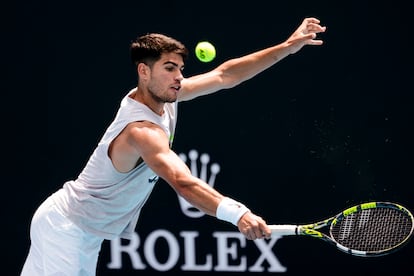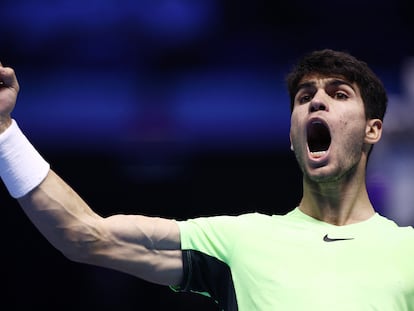Samuel López, Alcaraz’s guide in Melbourne: ‘Carlos knows how to listen, he makes it easy for you’
The man from Alicante, Ferrero’s replacement on the Spanish bench, praises the player’s ‘joy’ and says that he should not lose his ‘spontaneity’ on and off the court


“That one was in. I saw it go in, right, Samu?”
Court 16 of Melbourne Park is packed with spectators on all four sides who have come to watch Carlos Alcaraz perform. He is training hard against the Serbian Dusan Lajovic and is seeking his coach’s approval. But no, it is not Juan Carlos Ferrero, his usual coach, but Samuel López, “Samu” as he is known in the world of Spanish tennis. López is a friendly, approachable man with a long history in tennis. These days, he is advising Spain’s young tennis ace at the Australian Open. This Tuesday Carlos Alcaraz made his debut in the tournament against the Frenchman Richard Gasquet with a resounding three set victory (7-6, 6-1, 6-2). There is agreement, good vibes, two-way communication in their dialogues. The young Spaniard abides by the details and his coach exudes optimism during the conversation that takes place at the locker room door.
“To tell the truth, everything has gone very well. He has enthusiasm, desire and he’s motivated. Carlos is motivated to have a great tournament and I think he is ready. Then, of course, you have to hope for a little bit of luck, right? Having a little luck is always important. But he looks good, he’s ready for the battles that are going to come from now on,” says López when asked about the first week of his stay in the antipodes. The tennis player has continued to hone his skills for his assault on the first big tournament of the season that begins with the Australian Open. Alcaraz’s defined muscles gleam with sweat and tense even more when he executes one of the meteoric blows that impress the fans.
With eagle eyes, López watches and analyzes every movement. The player’s father and one of his uncles watch from the stands, and his personal doctor, Juanjo López, occasionally acts as ball boy while the physio, Juanjo Moreno, worries about hydration and electrolytes during the session. Everything seems ready. Or it looks that way from a distance, as the coach present intends it to. Ferrero is interested in the boy’s day-by-day development. Three days earlier when asked for news from the bench — about the arthroscopy the other great Spaniard, Rafa Nadal, had recently undergone — Ferrero expressed himself forcefully: “I believe in him. I trust Samu one hundred percent. “He has years and years of experience.”
Juanjo López was a modest player in his mid-twenties when he joined Antonio Martínez Cascales, Ferrero’s mentor and current patriarch of the Alcaraz team. Together they founded the academy based in Villena (Spain), in 1990. They worked together on developing the erstwhile number one, and for eight years he has directed the career of Pablo Carreño, another Spaniard who has been out of action for months as a result of a nasty tendonitis in his elbow. Like Careño, Alcaraz exercises throughout the year in Villena, where López quickly spotted that the 15-year-old teenager had that special something: an instinct, an imagination, and a first-class serve.
The first shots
“That’s something innate, right? Then, as you grow, you mature, but our idea is that you don’t lose that, because at the end of the day it is your essence. He has that spontaneity on and off the court, and he shouldn’t lose it. But, obviously, as the player matures, he becomes more ordered,” he says before remembering that tennis offers very narrow margins to polish technical or strategic aspects, and that, basically, it has to be done almost on the fly. However, the five weeks of preseason training have been great for Alcaraz to refine a double aspect: service and return, which are both even more important in the current game record.

“You always improve from the base you already have, and Carlos is a happy player, who likes to dominate. To be able to do so, the first shots are very important in tennis, and even more so in modern tennis. So emphasis has been placed on both the serve and the rest, and on not hesitating when going forward. That has been the foundation, apart from maintaining the intensity and paying attention to the details. And I believe that he has improved,” López continues in accordance with the continuous line that unites him and Ferrero, whom he already replaced last year in Queens and two matches before that in Miami. On both occasions, Samu accompanied the champion in the photo.
“I have known Juan Carlos for a long time, and he knows me. We have the same idea for working with Carlos, so everything is easy. We have a lot of respect for each other, in the same way that Carlos shows it towards us. He does everything you tell him. He’s a kid who listens, so it’s easy to work with him,” explains the man from Alicante on Spain’s Mediterranean coast. Alcaraz, meanwhile, appreciates the complementary formula because what interests him, above all, is taking it all in. “Because of experience, it can give you other types of things that Juan Carlos may not be able to tell you or teach you, even though he was a player and number one himself. In the end, we are all a team, so I try to learn as much from one as from the other,” says Alcaraz, ready to get onboard.
IT ALL STARTED WITH GASQUET
Richard Gasquet's name is the first on Alcaraz's map to the final in Melbourne. The Frenchman, distinguished by his aesthetic one-handed backhand, is already a veteran who, at the age of 38, if there is no change of plans, will hang up his racquet next spring after playing at Roland Garros.
He and the Spaniard have only faced each other on one occasion so far. It was three years ago, in Umag. Alcaraz won by a double 6-2 and celebrated his first title on the ATP circuit. “I have matured a lot”, he told EL PAÍS that night.
Sign up for our weekly newsletter to get more English-language news coverage from EL PAÍS USA Edition
Tu suscripción se está usando en otro dispositivo
¿Quieres añadir otro usuario a tu suscripción?
Si continúas leyendo en este dispositivo, no se podrá leer en el otro.
FlechaTu suscripción se está usando en otro dispositivo y solo puedes acceder a EL PAÍS desde un dispositivo a la vez.
Si quieres compartir tu cuenta, cambia tu suscripción a la modalidad Premium, así podrás añadir otro usuario. Cada uno accederá con su propia cuenta de email, lo que os permitirá personalizar vuestra experiencia en EL PAÍS.
¿Tienes una suscripción de empresa? Accede aquí para contratar más cuentas.
En el caso de no saber quién está usando tu cuenta, te recomendamos cambiar tu contraseña aquí.
Si decides continuar compartiendo tu cuenta, este mensaje se mostrará en tu dispositivo y en el de la otra persona que está usando tu cuenta de forma indefinida, afectando a tu experiencia de lectura. Puedes consultar aquí los términos y condiciones de la suscripción digital.
More information
Archived In
Últimas noticias
Most viewed
- Oona Chaplin: ‘I told James Cameron that I was living in a treehouse and starting a permaculture project with a friend’
- Sinaloa Cartel war is taking its toll on Los Chapitos
- Reinhard Genzel, Nobel laureate in physics: ‘One-minute videos will never give you the truth’
- Why the price of coffee has skyrocketed: from Brazilian plantations to specialty coffee houses
- Silver prices are going crazy: This is what’s fueling the rally









































